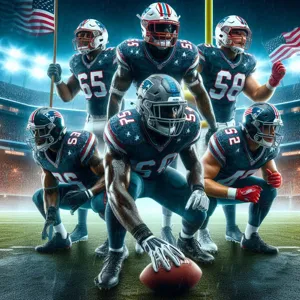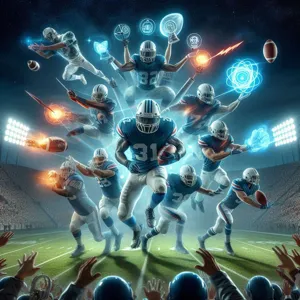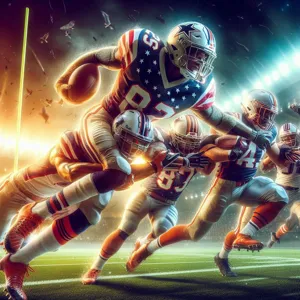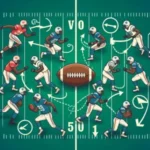In the dynamic arena of American football, where every second counts and every play can shift the tide of the game, special teams often serve as the unsung heroes.
While the spotlight typically shines on star quarterbacks and running backs, the strategic brilliance of special teams can make the difference between victory and defeat. From expertly executed kickoffs and field goals to game-changing punt returns, the nuances of special teams play are crucial to maximizing a team’s overall impact on the field. In this comprehensive guide, we’ll delve into the essential strategies for honing effective special teams play, exploring everything from player roles and formations to innovative techniques that can elevate your team’s performance. Whether you’re a coach aiming to sharpen your squad’s skills or a passionate fan eager to understand the intricacies of this vital aspect of the game, join us as we uncover the secrets to mastering special teams and turning potential into powerful results.
1. Understanding the Role of Special Teams in Football

### understanding the Role of Special Teams in Football
In the grand tapestry of American football, where every play can shift the momentum of a game, the role of special teams is often overlooked yet crucial. Special teams consist of a unique ensemble of players dedicated to specific situations, including kickoffs, field goals, extra points, and punts. While they may not receive the same spotlight as the offense or defense, their contributions can be the difference between victory and defeat.
At its core, special teams are responsible for controlling the field position, a critical factor that influences the overall strategy of the game. A well-executed kickoff can pin opponents deep in their own territory, forcing them to navigate a challenging field. Conversely, a mishandled punt return can give the opposing team prime real estate, setting them up for scoring opportunities.
Moreover, special teams are where some of the most exciting plays unfold. From thrilling returns that electrify the crowd to game-changing blocked kicks, these moments can define the rhythm and energy of a match. The importance of a reliable kicker cannot be understated, as their ability to convert crucial field goals can turn the tide of a close game.
Understanding the nuances of special teams play involves recognizing the diverse skill sets required for each position—from the powerhouse blockers who create gaps on returns to the agile, quick-footed returners who can weave through defenders. Coaches meticulously craft their special teams strategy, analyzing opponent tendencies and devising plays that can exploit weaknesses.
In summary, while the offensive and defensive units often steal the show, special teams are the unsung heroes of football. Their ability to shift the momentum, control field position, and create game-changing moments highlights their indispensable role in the sport. Embracing this understanding is the first step toward maximizing the impact of special teams and elevating overall team performance on the gridiron.
2. Key Components of a Successful Special Teams Unit
When it comes to special teams play in American football, success hinges on several key components that work in unison to create a formidable unit. Understanding these components can make all the difference between a mediocre performance and one that swings the momentum of a game in your favor.
**1. Skilled Personnel:** The backbone of any successful special teams unit is its personnel. This includes not only specialists like kickers, punters, and long snappers but also a dedicated group of athletes who excel in coverage, blocking, and tackling. Each player must understand their specific role and execute it with precision. A reliable kicker can turn the tide with a game-winning field goal, while a punter can pin the opposing team deep in their own territory, setting the stage for your defense to shine.
**2. Effective Coaching:** Leadership is critical in cultivating a strong special teams unit. Coaches must possess a deep understanding of the intricacies of special teams play, from strategy to technique. They should be adept at teaching their players not only the “how” but also the “why” behind each play. Regular film sessions, focused drills, and situational practice can help build a cohesive unit that is well-prepared for any scenario.
**3. Communication:** Clear communication is vital during special teams plays, where split-second decisions can greatly impact outcomes. From the huddle to the field, players must be in sync, calling out signals and adjustments as needed. Fostering a culture of open communication helps ensure everyone is on the same page, reducing the risk of mistakes that can lead to big plays for the opposition.
**4. Attention to Detail:** In special teams, the smallest details can have the largest consequences. Whether it’s the angle of a block, the speed of a coverage player, or the trajectory of a kick, attention to detail is paramount. Players must consistently focus on their fundamentals, ensuring that techniques are executed flawlessly. This discipline can be the difference between a successful play and one that falls apart under pressure.
**5. Adaptability:** The ability to adapt to changing circumstances is another hallmark of a successful special teams unit. This includes adjusting strategies based on the strengths and weaknesses of the opposing team, as well as responding to in-game developments. A unit that can think on its feet and make quick adjustments will be far more effective in capitalizing on opportunities that arise during the game.
In summary, a successful special teams unit is built on skilled personnel, effective coaching, clear communication, meticulous attention to detail, and adaptability. By focusing on these key components, teams can maximize their impact on the field and contribute significantly to their overall success. As the saying goes, special teams win games, and mastering these elements is essential for any football squad aiming for victory.
3. Strategies for Kickoff Coverage: Staying Disciplined and Effective

Kickoff coverage plays a pivotal role in determining field position and setting the tone for the game, making it essential for teams to approach this phase with discipline and strategy. The kickoff team must operate like a well-oiled machine, where each player’s role is defined and execution is precise.
To maximize effectiveness, players should focus on maintaining their lanes. As the ball is kicked, each member of the coverage team must sprint down the field while adhering to their assigned lane, avoiding the temptation to converge on the ball carrier prematurely. This disciplined approach not only minimizes confusion but also allows for a more organized pursuit of the returner, increasing the chances of a successful tackle.
Another crucial strategy is to leverage speed and agility. The kickoff coverage team should include some of the fastest players on the roster, as their ability to cover ground quickly can disrupt the returner’s momentum. In practice, emphasize drills that enhance burst speed and lateral movement, allowing players to react swiftly to the returner’s evasive maneuvers.
Communication is also key during kickoff coverage. Players must call out their responsibilities and alert teammates to any changes in the return formation. This ensures that everyone is on the same page and can adjust their positioning accordingly. Utilizing hand signals or coded phrases can help maintain clarity amidst the chaos of the kickoff.
Finally, studying film of opposing return teams can provide invaluable insights. Understanding their tendencies, preferred routes, and the strengths of their returners allows the coverage team to anticipate plays and respond strategically. By analyzing previous game footage, teams can develop tactics that exploit weaknesses and enhance their chances of containing the returner.
In summary, effective kickoff coverage hinges on discipline, speed, communication, and preparation. By instilling these principles, teams can maximize their impact during this critical phase of the game, ultimately leading to greater success on the field.
4. Mastering Kickoff Returns: Techniques for Explosive Plays
Kickoff returns can be one of the most electrifying moments in American football, capable of shifting the momentum of a game in the blink of an eye. To master this critical aspect of special teams play, teams must focus on a combination of technique, strategy, and teamwork to execute explosive returns that can set the field ablaze.
First and foremost, it’s essential to establish a solid formation. A well-organized return unit can create lanes for the returner, allowing them to exploit gaps in the coverage team. Utilizing various formations—such as the wedge or a spread alignment—can keep opponents guessing and prevent them from easily predicting your tactics. The key is to ensure that blockers effectively communicate, positioning themselves to shield the returner from oncoming defenders.
Next, the returner must hone their individual skills. Agility, speed, and vision are paramount. The ability to read blocks and anticipate the movements of opposing players can make the difference between a modest gain and a game-changing touchdown. Practicing footwork drills and agility exercises can sharpen these skills, enabling the returner to make quick cuts and find open space as they navigate through the chaos of the return.
Equally important is the timing of the return. A successful kickoff return hinges on the interplay between the kicker’s trajectory and the returner’s positioning. Coaches should emphasize the importance of catching the ball cleanly and swiftly transitioning into a running posture. This involves practicing the art of fielding the kick at various heights and angles, allowing the returner to adapt to any situation they may face on the field.
Moreover, communication is crucial. Pre-play signals can help the return team coordinate their movements and adjust to the coverage scheme they encounter. Whether it’s a simple call to indicate a specific return path or a signal to alert teammates to a potential block, effective communication ensures that the team operates as a cohesive unit.
Lastly, studying film is an invaluable tool for improvement. Analyzing past performances can reveal patterns in opposing teams’ kickoff coverage, allowing your return team to devise a game plan that exploits their weaknesses. Identifying tendencies—such as how coverage players align or their approach angles—can provide critical insights that shape your strategy leading into each game.
By mastering these techniques and fostering a deep sense of teamwork, teams can transform kickoff returns into powerful offensive weapons. When executed flawlessly, these explosive plays not only energize players and fans alike but can also turn the tide of a game, making special teams a force to be reckoned with on the gridiron.
5. Punting Strategies: Importance of Hang Time and Placement

In the intricate dance of American football, punting serves as a critical juncture that can dramatically shift the momentum of a game. While many fans may focus on the distance a punter can achieve, seasoned coaches and players understand that two elements reign supreme in crafting a successful punt: hang time and placement.
Hang time refers to the duration the ball remains airborne after it’s kicked. A longer hang time not only allows coverage teams to sprint down the field but also gives them the opportunity to position themselves strategically for an effective tackle. This delay can disrupt the returner’s rhythm, forcing them to make split-second decisions under pressure. The ideal hang time typically ranges between 4.5 to 5 seconds, giving your coverage team the edge they need to swarm the returner, minimizing the potential for explosive plays.
However, hang time alone is insufficient without precise placement. The trajectory of the punt should target the sidelines or land in a specific zone where returners have less space to maneuver. By angling the punt toward the sideline, punters can effectively limit the returner’s options, pushing them toward the boundary—which not only reduces the likelihood of a long return but can also lead to advantageous field positioning. A well-placed punt can pin the opponents deep in their territory, forcing them to begin their drive under duress.
Moreover, effective punting strategies often incorporate deception. A punter can employ various techniques—such as a rugby-style kick or a quick kick—to catch the coverage team off guard. The element of surprise can create opportunities for turnovers or favorable bounces, further amplifying the punter’s impact on the game.
In essence, mastering the art of punting goes beyond sheer distance; it’s about precision, timing, and tactical execution. When hang time and placement are executed flawlessly, punters not only elevate their own performance but also serve as pivotal players in the grand strategy of football, influencing the outcome of games and the fate of seasons.
6. The Art of Punt Returns: Evaluating Risks and Rewards
Punt returns are often the unsung heroes of special teams play, capable of shifting momentum and electrifying the crowd. However, mastering the art of punt returns requires a keen understanding of the risks and rewards involved. This nuanced dance between caution and aggression can either lead to a game-changing play or an unfortunate turnover.
At the heart of a successful punt return is the returner’s ability to read the field. As the ball soars through the air, the returner must quickly assess the position of both the punter’s coverage unit and the blockers in front. Timing is crucial; a split second can mean the difference between a fair catch and a daring run. The most effective returners possess an instinctive feel for when to call for a fair catch—a wise choice in situations where the coverage team is barreling down—or when to seize the opportunity to advance the ball.
But it’s not just about individual skill; every successful punt return relies on team synergy. A well-coordinated blocking scheme can create lanes that allow the returner to navigate past defenders. Coaches must meticulously design these schemes, ensuring that each player understands their role and the importance of maintaining their blocks. A returner who is well-supported by a cohesive unit can take calculated risks, trusting that his teammates will create the necessary space for a big gain.
Moreover, understanding the dynamics of field position is critical. Coaches and players must assess the potential rewards of a return against the risk of a turnover. A return that could place the offense in excellent field position may be worth the gamble, but a risky return in deep territory could lead to a costly fumble. By evaluating these situations, players can make informed decisions that align with the team’s overall strategy.
Ultimately, the art of punt returns encapsulates the essence of special teams play: it’s about striking a balance between aggression and prudence. A successful return can energize a team and its fanbase, while a miscalculation can dampen spirits. By honing their skills, establishing effective blocking strategies, and making thoughtful decisions under pressure, teams can maximize the impact of their punt returns, turning these pivotal moments into game-changing plays.
7. Field Goal and Extra Point Success: Importance of Timing and Coordination

In the high-stakes arena of American football, every point counts, and the execution of field goals and extra points can often be the difference between victory and defeat. This is where timing and coordination come into play, transforming a seemingly simple play into a finely-tuned machine.
Successful field goal attempts hinge on the seamless collaboration of three critical components: the snapper, the holder, and the kicker. The snapper must deliver a precise, quick snap to the holder, who then has mere seconds to secure the ball, position it correctly, and set it down for the kicker. This process requires not only individual skill but also an extraordinary level of synchronicity between players. Any misstep, whether it’s a slow snap or an unsteady hold, can lead to a missed opportunity, leaving fans and teammates alike holding their breath in anticipation.
Moreover, the psychological aspect of timing cannot be understated. As the kicker approaches the ball, they must remain focused amidst the electric atmosphere of the stadium, often under the watchful eyes of thousands. A successful kick is not just about strength; it’s about mental fortitude and the ability to execute under pressure. The timing of the kick—especially in relation to the snap and the hold—can make or break the attempt.
In addition to honing their physical skills, teams must practice these plays repeatedly, developing an almost instinctual understanding of each other’s movements. They must learn to anticipate and react as a cohesive unit, allowing them to maintain their composure when the game is on the line.
In conclusion, the success of field goals and extra points is a testament to the power of teamwork and precision. By prioritizing timing and coordination in practice, teams can maximize their scoring potential, ensuring that every opportunity counts when it truly matters.
8. Special Teams Player Development: Skills and Training Regimens
When it comes to the often-overlooked realm of special teams in American football, player development is crucial for maximizing impact on the field. Unlike offensive and defensive players, special teams athletes must possess a unique blend of skills that cater to their specific roles, whether they are kickers, punters, long snappers, or coverage specialists. This section delves into the essential skills and tailored training regimens that can elevate a player’s performance and enhance the overall effectiveness of special teams.
First and foremost, specialized skills training is fundamental. For kickers and punters, mastering the mechanics of kicking is paramount. This includes everything from foot placement and follow-through to understanding the physics of trajectory and distance. Incorporating drills that focus on accuracy and power in varying weather conditions can help players adapt to any game-day scenario. Long snappers, on the other hand, need to concentrate on precision and speed; they often train with snap drills to hone their technique, ensuring that the ball reaches the holder or punter with pinpoint accuracy.
In addition to these specialized skills, conditioning is vital for all special teams players. Training regimens should include agility drills, strength training, and cardiovascular conditioning to ensure players can perform at their peak during crucial moments of the game. Plyometric exercises can enhance explosiveness, which is essential for coverage players who need to react quickly and decisively. Incorporating situational drills that mimic game scenarios not only sharpens skills but also builds the mental toughness required to execute under pressure.
Moreover, fostering a strong team culture is key to special teams success. Regular film sessions allow players to analyze their performances, learn from their mistakes, and study opponents’ tendencies. Communicating effectively and building trust among teammates can make a significant difference in executing plays flawlessly.
Ultimately, prioritizing the development of special teams players through focused skill training, conditioning, and teamwork can lead to improved execution on the field. By investing time and resources into this often-underappreciated aspect of the game, teams can maximize their overall impact and secure those critical, game-changing moments that can turn the tide in their favor.
9. Analyzing Opponent Tendencies: Preparing for Special Teams Situations
Analyzing opponent tendencies is a crucial aspect of preparing for special teams situations that can make or break a game. Special teams play often serves as the tipping point in closely contested matchups, and understanding your adversary’s habits can provide a significant edge. Coaches and players should dedicate time to dissecting game film, focusing on how the opposing team operates during kickoffs, punts, and field goal attempts.
By meticulously studying video footage, you can identify patterns in formations, player movements, and strategic decisions made during various game scenarios. For instance, does the opposing kickoff team always favor a particular side of the field? Are they more aggressive or conservative when defending a punt return? These insights can inform your own game plan, allowing you to anticipate their actions and adjust your strategies accordingly.
Moreover, leveraging data analytics can further enhance your understanding of opponent tendencies. Many teams now utilize advanced metrics to evaluate the effectiveness of their special teams play and that of their competitors. This quantitative approach can reveal hidden trends, such as specific player matchups that favor your squad or exploitable weaknesses in the opponent’s coverage unit.
Additionally, communication is key. Share your findings with your special teams unit and ensure every player understands the plan. Conducting walkthroughs that simulate known tendencies helps reinforce the strategy and prepares players mentally and physically for what they may encounter on the field.
Ultimately, thorough analysis of opponent tendencies not only fuels a proactive game plan but also instills confidence in your special teams players, empowering them to execute with precision and decisiveness when the moment counts the most. By capitalizing on this aspect of preparation, you can significantly elevate the performance of your special teams and maximize their impact on the game.
10. The Importance of Communication in Special Teams Play
In the high-stakes realm of American football, where every second counts and split-second decisions can dictate the outcome of a game, communication emerges as a cornerstone of effective special teams play. Unlike other units on the field that may have more time to strategize before a play, special teams operate in a fast-paced environment where clarity and precision are paramount.
Effective communication begins long before the snap of the ball. It’s established during practice sessions, where players should engage in drills that not only sharpen their technical skills but also enhance their ability to convey crucial information quickly. Whether it’s calling out formations, signaling shifts, or alerting teammates to changes in coverage, every player must be attuned to the flow of the game and the dynamics of their specific roles.
On the field, verbal cues and non-verbal signals become vital tools. A simple shout or hand gesture can mean the difference between a successful block and a missed assignment. Moreover, players must develop a shared vocabulary that allows for quick, clear communication in the heat of the moment. This is especially important for kickers and punters, who rely on their teammates to set up the play and protect them from oncoming defenders.
Additionally, fostering strong relationships among special teams players enhances communication. Trust and familiarity breed confidence, enabling players to make split-second adjustments without hesitation. Coaches should emphasize the importance of teamwork, encouraging players to build rapport through team-building activities and regular discussions about strategy.
In the end, the importance of communication in special teams play cannot be overstated. It is the thread that weaves together individual efforts into a cohesive unit capable of executing intricate plays under pressure. By prioritizing effective communication, teams can maximize their impact on the field, turning special teams into a game-changing force that contributes significantly to overall success.
11. Creating a Game Plan: Adapting Strategies for Different Opponents
Creating a game plan tailored to the unique strengths and weaknesses of different opponents is crucial for effective special teams play in American football. Unlike the offensive and defensive units, special teams often have a smaller window to make a significant impact on the game, meaning that each play must be meticulously crafted and executed.
Before each game, thorough analysis and scouting reports should be conducted to identify the opponent’s tendencies. For example, if your opponent has a history of struggling against high-pressure kick returns, consider deploying your fastest players in a formation designed to exploit this weakness. Alternatively, if they excel in blocking kicks, it may be wiser to employ a more conservative approach, focusing on securing the ball rather than taking risks.
Adaptability is key; an effective special teams coordinator must be ready to pivot their strategy mid-game based on the unfolding dynamics. If your initial game plan falls flat—say the opposing team’s punter consistently boots the ball beyond the returner’s reach—be prepared to adjust your return strategies. This might involve altering your alignment or even pulling a player to dedicate more resources to blocking.
Moreover, communication on the field cannot be overstated. Ensuring that all players understand their roles and responsibilities within the game plan is vital. Conducting regular walkthroughs and film sessions will help reinforce this understanding and prepare the team for the various scenarios they may face.
Ultimately, creating an adaptable game plan that recognizes the specific characteristics of each opponent empowers your special teams to seize opportunities as they arise. With a well-thought-out strategy, your special teams can not only maintain momentum but also create game-changing plays that can swing the tide in your favor.
12. Utilizing Analytics to Enhance Special Teams Performance
In the high-stakes world of American football, every play counts, and special teams often serve as the unsung heroes, tipping the scales in tightly contested games. To truly maximize their impact, teams must embrace the power of analytics. By leveraging data-driven insights, coaches and players can refine their strategies, optimize player positioning, and enhance overall performance.
Analytics in special teams play can encompass a variety of metrics, from kickoff and punt return yardage to field goal success rates and coverage efficiency. By analyzing these statistics, coaches can identify patterns and trends that reveal their unit’s strengths and weaknesses. For instance, detailed breakdowns of opponents’ kicking and punting habits can inform the team on when to expect trick plays or onside kicks, allowing for better preparedness.
Furthermore, advanced tracking technology has transformed the landscape of player evaluation. Coaches can now monitor player movements in real-time, scrutinizing everything from acceleration and speed to tackling angles and reaction times. This data allows them to tailor practices to enhance individual skills and improve overall unit cohesion.
Moreover, film analysis combined with analytics offers a powerful tool for learning and improvement. By reviewing game footage alongside performance data, teams can dissect successful plays and pinpoint areas for growth. This comprehensive approach fosters a culture of continuous learning, where players are motivated to adapt and evolve their techniques based on empirical evidence.
Incorporating analytics into special teams strategy not only enhances performance but also empowers players. When athletes understand the “why” behind their roles and responsibilities, they become more engaged and invested in the team’s success. Ultimately, by utilizing analytics effectively, teams can transform their special teams units from mere footnotes in the playbook into pivotal forces that change the outcome of games.
13. Special Teams in High-Pressure Situations: Performing Under Stress
Special teams play a crucial role in the dynamics of American football, particularly in high-pressure situations where every second counts and every decision can sway the outcome of the game. Whether it’s a last-minute field goal attempt, a crucial punt return, or an onside kick, special teams units must remain composed and focused despite the mounting tension.
In these critical moments, the ability to perform under stress is paramount. Players must rely on their training, instincts, and teamwork to execute plays flawlessly. One effective strategy is to simulate high-pressure scenarios during practice, creating an environment that mirrors the intensity of a real game. Coaches can set up drills that involve time constraints, loud crowd noise, or even simulated distractions to help players acclimate to the stress they will face on game day.
Communication is another key element. Special teams units must develop a strong rapport and clear lines of communication to ensure everyone is on the same page. In high-stress situations, miscommunication can lead to costly mistakes. Establishing hand signals, code words, and even visual cues can help streamline communication and ensure that each player knows their role, even when the stakes are at their highest.
Mental resilience is equally important. Players must cultivate a mindset that embraces pressure rather than shies away from it. Techniques such as visualization, positive self-talk, and breathing exercises can help athletes stay calm and focused when the game hangs in the balance. Encouraging players to visualize success and rehearse their roles mentally can build confidence and reduce anxiety.
Ultimately, the key to special teams excelling in high-pressure situations lies in preparation, communication, and mental fortitude. By embracing these strategies, teams can turn potential pressure into an opportunity for greatness, making pivotal plays that can lead them to victory when it matters most.
14. Case Studies: Successful Special Teams Plays from Recent Games
When it comes to analyzing the effectiveness of special teams in American football, nothing illustrates their impact better than real-world examples. In recent seasons, several games have showcased innovative strategies and jaw-dropping execution that highlight the pivotal role special teams play in influencing the outcome of matchups.
Take, for instance, the thrilling showdown between the Kansas City Chiefs and the New England Patriots last season. In a critical moment during the second quarter, the Chiefs executed a brilliantly designed fake punt that caught the Patriots completely off guard. With the defense focused on the potential punt, the punter took a snap, sprinted to the right, and connected with an unsuspecting receiver downfield for a crucial first down. This bold move not only shifted momentum but also demonstrated the importance of creativity and timing in special teams play.
Another fascinating case study comes from a nail-biting game between the Baltimore Ravens and the Cincinnati Bengals. In the final minutes of the fourth quarter, the Ravens found themselves trailing by three points. With just seconds left on the clock, they opted for a field goal attempt to tie the game. However, it was the Ravens’ special teams that truly shined when they executed a well-rehearsed “swinging gate” formation. As the snap came, the line shifted and the holder transitioned into a pass play. The unexpected throw to a tight end who slipped into the end zone secured not only the tie but also a surge of energy that propelled the Ravens into overtime.
These case studies serve as a reminder that special teams are not just an afterthought in game strategy; they are a critical component that can turn the tide of a game. The success of these plays showcases the importance of meticulous planning, execution, and the ability to adapt on the fly. Coaches and players alike can glean valuable lessons from these moments, reinforcing the notion that every point counts and that special teams can indeed be game changers. By embracing innovative strategies and analyzing past successes, teams can further maximize their impact in this often-overlooked aspect of the game.
15. Conclusion: The Future of Special Teams in American Football
As the game of American football continues to evolve, so too does the role and significance of special teams. Historically viewed as an afterthought, special teams are now recognized as a vital component of a team’s overall strategy and success. With the advent of advanced analytics, coaches are increasingly prioritizing special teams play, understanding that even the smallest margin of success in this area can tilt the outcome of a game.
Looking ahead, the future of special teams in American football is likely to be shaped by several key trends. First, we can expect greater emphasis on player specialization. Just as offensive and defensive players have distinct skill sets, special teams will see more athletes being recruited specifically for their abilities in this arena. This shift will lead to enhanced performance and increased competitiveness on kickoffs, punts, and field goal attempts.
Additionally, as teams innovate with their formations and strategies, we may witness a rise in unconventional approaches on special teams. Coaches are likely to experiment with different alignments and techniques designed to maximize yardage gains and disrupt opponents’ plays. This creativity will not only keep opposing teams guessing but will also provide thrilling moments for fans.
Finally, technology will play a pivotal role in the evolution of special teams. With advancements in video analysis and real-time data tracking, teams will have unprecedented access to insights that can refine their strategies. Coaches will be able to break down plays more effectively, allowing them to make informed decisions about personnel and tactics that can lead to success in critical moments.
In conclusion, as American football progresses into a new era, special teams will no longer be seen as a secondary aspect of the game. Their significance will only increase, influencing not just the scoreboard but the very fabric of team dynamics. Embracing innovation, specialization, and technology will ensure that special teams remain a critical factor in the quest for victory, captivating fans and players alike for years to come.
As we conclude our exploration of strategies for effective special teams play in American football, it’s clear that mastering this crucial aspect of the game can significantly enhance your team’s overall performance. Whether it’s refining your kickoff strategies, honing your field goal techniques, or perfecting punt coverage, the impact of a well-coordinated special teams unit cannot be overstated. By implementing these strategies, you not only boost your team’s chances of success on the field but also instill a sense of discipline and teamwork among your players. As you head into your next practice or game, carry these insights with you, and watch as your special teams transform into a formidable force that can change the course of any match. Here’s to maximizing your impact and achieving victory one play at a time!






